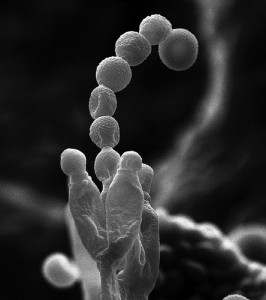With Valentine’s Day only a few days away, love is definitely in the air. As it turns out, even fungi are in the mood!

Valentine’s Day Cupcakes. Sugar Daze via Flickr Creative Commons.
A recent study has discovered that Penicillium chrysogenum (P. chrysogenum) have a sexual side. While you may not recognize the name P. chrysogenum, it is likely that at some point in your life you have depended on this fungus to help you feel better. P. chrysogenum is popularly known for its production of the antibiotic penicillin, which has been used for treating bacterial infections since it was discovered by Sir Alexander Fleming in 1928.
Penicillin works by preventing bacteria from building cell walls. Lacking this external support, the bacterial cell is very fragile and bursts, resulting in death of the cell (click here to watch this process). As we do not possess the same cell wall components as bacterial cells, penicillin is an effective treatment for human bacterial infections, as the antibiotic interferes with bacterial cells but not our own cells!

Penicillium Growing on Bread. Logan Sakai via Flickr Creative Commons.
Previously, it was thought that P. chrysogenum only underwent asexual reproduction. In this reproductive strategy, fungal cells duplicate their genetic material and divide, resulting in two identical clones called daughter cells.
However, researchers suspected that P. chrysogenum would be able to sexually reproduce if provided with the right conditions, as the genetic sequences required for mating could be found within the DNA of this species. Supporting this belief, a recent experiment by Bohm et. al has shown that when proper conditions are met, P. chrysogenum fungi will sexually mate to produce new genetic strains of offspring.

Scanning Electron Microscope (SEM) Image of P. chrysogenum Fungus. Engineering at Cambridge via Flickr Creative Commons.
This discovery has been dubbed the “secret sex life” of P. chrysogenum. So, light the candles, turn on some romantic music, and spread out the rose petals?
Not quite; these fungi require a special “love potion”. After testing a variety of light and nutrient conditions, experimenters found that P. chrysogenum engaged in sexual mating when grown in darkness, in an oatmeal base supplemented with biotin (a vitamin).
Furthermore, researchers found that fungi engaging in sexual activity also produced more penicillin than asexual fungi. These findings are important on an industrial level, as sexual strains can be used to maximize penicillin output when synthesizing this antibiotic for medical usage. While high antibiotic-producing strains have been engineered before, they are genetically unstable and have short lifespans. However, knowing that sexual reproduction in P. chrysogenum occurs, engineered strains can be sexually mated with normal strains to produce offspring that are both genetically stable and produce large quantities of antibiotic.
While I can’t promise that oatmeal and biotin will help you get lucky this Valentine’s Day, it appears that you won’t need to worry about a penicillin shortage in the near future!
– Sydney Schnell





